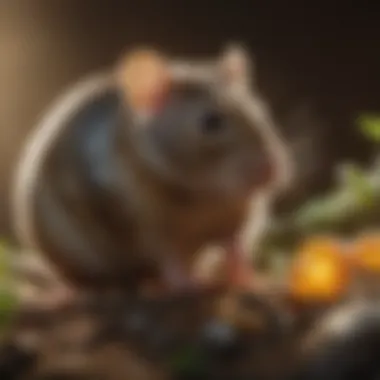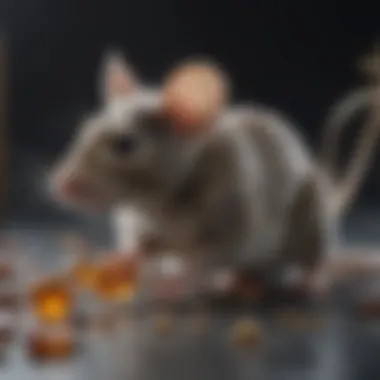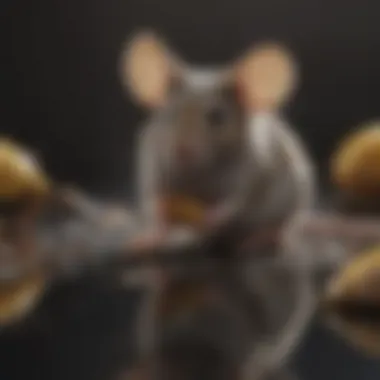Lethal Substances for Mice: A Comprehensive Guide


Intro
Understanding the substances that can be lethal to mice is crucial for effective pest control. Mice can invade homes, causing damage and health risks. Their populations can grow quickly due to their breeding rates. Knowing what can impact them helps homeowners manage infestations responsibly.
This article explores a mix of natural and synthetic substances that can be harmful to mice when ingested. We aim to analyze their mechanisms and the necessary precautions for using them safely. The goal is to provide clear guidance to homeowners and housewives seeking solutions for rodent problems.
Identification of Common Pests
Description of Common Pests
Mice are the most common household pests. The house mouse, Mus musculus, is small, typically gray or brown. They have a high reproductive rate, which allows them to infest structures swiftly. Another common type is the field mouse, known for entering buildings in search of food during colder months. Each species has distinct habits but similar impacts on human environments.
Signs of Infestation
Identifying the signs of mice can prevent larger problems. Look for:
- Droppings: These are small and dark, often found near food sources.
- Nesting Materials: Shredded paper or fabric indicates nesting activity.
- Gnaw Marks: Mice chew on various materials; evidence can be seen on food packaging.
- Strange Noises: Scratching or scurrying sounds in walls or ceilings.
Recognizing these signs early can help mitigate infestations before they become severe.
Prevention Techniques
Home Maintenance Tips
Preventing mice requires proactive measures. Ensure windows and doors are sealed tightly to prevent entry. Regularly check and repair holes in walls, baseboards, or foundations. Keep food in sealed containers, and maintain cleanliness to minimize tempting food sources.
Environmental Modifications
Creating barriers in the environment is effective. Trim back shrubs and keep firewood stacked away from home to reduce potential nesting sites. Ensure rubbish is cleaned regularly and stored in secured bins. These simple modifications can significantly impact mouse behavior around your property.
Eco-Friendly Pest Control Options
Natural Pesticides
For those preferring non-toxic methods, natural pesticides can be considered. Some substances can be effective in deterring mice without harming the environment. Natural deterrents include:
- Peppermint oil: Strong-smelling oil can repel mice.
- Cayenne pepper: Sprinkling can help discourage entry.
- Boric acid: Used responsibly, it can be placed in areas where mice frequent.
Organic Pest Control Techniques
Using organic techniques can assist in mouse management. Traps made of wood or recycled materials are often considered. Avoid using glue traps, which may cause prolonged suffering. Evaluate options such as live traps that allow for relocation of captured mice without lethal consequences.
By integrating these practices, homeowners can manage mouse populations effectively. Understanding these substances and strategies ensures a responsible approach to pest control, addressing both immediate needs and long-term prevention.
Understanding Rodent Biology
Understanding rodent biology is critical for those who deal with rodent infestations. This knowledge informs methods for effective control and management. Mice are particularly resilient animals with unique characteristics that make them well-adapted to various environments. By familiarizing oneself with their physiological traits and nutritional needs, homeowners can devise more effective strategies for dealing with infestations.
Physiological Characteristics
Mice possess distinct physiological traits that influence their behavior and survival. They have a high reproductive rate, which can exacerbate any infestation. Female mice can give birth to up to twelve pups in a single litter and can reproduce multiple times a year. This rapid breeding can pose challenges for controlling populations. Their small size, typically around 2.5 to 4 inches long (not including the tail), enables them to access tight spaces and hidden areas.
Mice have specialized teeth designed for gnawing. Their incisors continuously grow throughout their lives, requiring them to chew on various materials to keep them from becoming too long. This trait is a consideration for homeowners, as it leads to potential damage to structures and belongings.
Additionally, the sensory capabilities of mice are noteworthy. They possess an acute sense of smell and hearing, which helps them detect food sources and potential threats. Understanding these characteristics helps in creating effective barriers and traps.


Nutritional Needs
Mice have specific dietary requirements that are essential for their survival. Their diet primarily consists of grains, seeds, and fruits, but they are opportunistic feeders. They can also consume insects and other small food sources if necessary. This omnivorous nature allows them to thrive in various settings, making it vital to manage food sources around homes to deter their presence.
A critical aspect of their nutrition is water intake. Mice require consistent access to water for hydration. In environments where food is abundant, they may also find water sources, meaning controlling these can be crucial in limiting infestations.
In summary, a thorough understanding of the physiological characteristics and nutritional needs of mice creates a foundation for effective pest control. Those who are aware of these factors will find it easier to address infestations while considering humane practices where appropriate. This understanding also aids in recognizing which substances may pose a lethal threat to these rodents, thereby enriching discussions in subsequent sections on methods and materials.
Common Substances Lethal to Mice
The topic of common substances lethal to mice holds significant relevance due to its implications in pest control and rodent management. Understanding these substances helps homeowners and pest control professionals deal with infestations effectively. These substances not only aid in eliminating the problem but also provide insights into safety measures and environmental consequences. Identifying the specific substances that can impact mice allows for a more targeted approach. It promotes responsibility in application, ensuring a balance between effectiveness and safety.
Anticoagulants
Mechanism of Action
Anticoagulants work by inhibiting the blood-clotting process in mice. When ingested, these substances disrupt the synthesis of vitamin K, essential for producing clotting factors in the liver. The mouse ultimately suffers from internal bleeding, leading to its death. This mechanism is highly efficient, making anticoagulants a popular choice in pest control. Their delayed effect means that the target animals will consume it without immediate suspicion. However, this can also pose a risk, as non-target species may also be affected if they ingest the anticoagulant.
Types of Anticoagulants
Several types of anticoagulants are available for rodent control, including first-generation and second-generation compounds. First-generation anticoagulants require multiple feedings for effectiveness. In contrast, second-generation anticoagulants are more potent and lethal after a single dose. This differentiation highlights the versatility of anticoagulant options, catering to various infestation scenarios. The unique feature of second-generation anticoagulants is their higher environmental persistence, which can be both a benefit and a drawback in residential areas.
Safety and Application
Safety is paramount when using anticoagulants. These substances should be placed in tamper-resistant bait stations to prevent accidental exposure to children and pets. Proper training and knowledge are essential when applying anticoagulants, as their use carries risks. Despite their effectiveness, these substances require careful handling and dispensation. The unique aspect of anticoagulants is the potential for secondary poisoning in predators that consume the affected mice.
Rodenticides
Comparison of Options
Rodenticides encompass various chemical formulations designed to kill rodents. They include anticoagulants, as well as non-anticoagulant options, which may cause immediate effects. The choice between these options often depends on the specific rodent problem encountered. The critical characteristic of rodenticides is their diverse mechanisms of action, where some may cause neurological disruption or gastrointestinal distress.
Dosing Guidelines
Establishing dosing guidelines helps ensure effective rodent control. Overdosing can lead to dangers, including environmental contamination and harm to non-target species. It is important to follow product instructions meticulously. This unique feature of rodenticides provides a structured approach to application and effectiveness, allowing users to gauge the required amount based on the severity of infestation and the specific product used.
Environmental Considerations
Using rodenticides raises important environmental considerations. Non-target species risk exposure to these chemicals. Therefore, it is crucial to choose products that are less harmful to the environment. Eco-friendly rodenticides provide options that work effectively while minimizing ecological damage. Their unique feature is often the use of fewer hazardous substances, aligning better with modern pest control standards.
Natural Substances
Plants Toxic to Mice
Certain plants are inherently toxic to mice. Examples include castor bean and yew plants, which contain compounds that are harmful upon consumption. Knowledge of these plants can help homeowners manage rodent populations naturally. What makes this approach beneficial is the reduced reliance on synthetic chemicals. However, the effects may not be immediate, and identification of local dangerous plants is essential, as some may pose risks to pets and children too.
Essential Oils
Essential oils, such as peppermint oil, can repel mice and discourage them from entering homes. Their strong scents act as a deterrent, making them a popular choice among homeowners seeking natural solutions. The appeal of essential oils lies in their safety profile compared to traditional poisons. However, their effectiveness may vary, and reapplication is often necessary to maintain their repellent properties.
Homemade Remedies
Homemade remedies using common household ingredients can also deter mice. For example, a mixture of vinegar and water may be sprayed in areas where mice are likely to enter. Home remedies generally present a low risk for non-target species, making them appealing for households concerned about safety. The limitation is that the results may not be as potent or lasting as manufactured products. A thorough understanding of chosen methods ensures the desired results are achieved.
Mechanisms of Action in Lethal Substances
Understanding the mechanisms through which lethal substances act on mice is essential for effective pest control. This knowledge allows individuals to select the best method for addressing rodent infestations. Additionally, recognizing how these substances interact with rodent biology helps ensure safety and efficacy.


Toxicity Levels
Toxicity levels refer to the degree of harm a substance can do to an organism. In the case of mice, different substances possess varying toxicity levels. Factors such as dosage, method of administration, and the individual mouse's health all influence outcomes.
- LD50 Values: This metric indicates the dose required to kill 50% of a test population. For example, anticoagulants have a relatively low LD50, making them highly effective even in small amounts.
- Variability amongst Species: Different species of mice may respond differently to the same toxic substance. A compound that is lethal to one variety may not affect another, highlighting the importance of specificity in pest control strategies.
- Factors Affecting Toxicity: Environmental variables such as temperature and food availability can affect how a substance works. Additionally, chronic exposure to lower levels of toxins can lead to bioaccumulation, resulting in increased lethality over time.
Absorption and Metabolism
The way substances are absorbed and metabolized in mice greatly affects their lethal potential. Once ingested, a substance must be absorbed into the bloodstream before it can exert any toxic effects.
- Absorption: Factors like the formulation of the substance, presence of food, and the mouse's physiological state are crucial. For example, anticoagulants are often fast-acting due to their high absorption rates in the digestive tract.
- Metabolism: This process involves the conversion of the substance into different compounds that can either be more or less toxic. Some substances may become more potent after metabolic transformations, while others are rendered harmless.
- Elimination: Understanding how quickly a substance is expelled from the body is essential. A slower elimination process may contribute to prolonged toxicity and greater harm to the organism.
"Knowledge of how lethal substances act at the biological level is paramount. It aids in the judicious application of pest control methods, minimizing unintended consequences."
Practical Applications of Lethal Substances
The use of lethal substances toward rodents, especially mice, serves both practical and strategic purposes for individuals facing pest issues. Understanding how these substances can be applied effectively is crucial. This section aims to discuss the key methods in rodent control, highlighting commercial pest control techniques and DIY methods for homeowners. Each approach carries its own set of benefits and drawbacks, making it important to evaluate based on specific needs and circumstances.
Commercial Pest Control Techniques
Commercial pest control methods generally utilize professional services that apply lethal substances scientifically and methodically. These techniques are often tailored for efficiency and effectiveness, minimizing the risk of misuse or unintended harm to non-target species.
- Targeted Application: Professionals often use highly targeted methods to ensure that the substances only affect the intended pests. This minimizes risks to pets and humans.
- Expertise: Trained pest control specialists understand local regulations and safety guidelines. They can select effective strategies based on their experience.
- Integrated Pest Management: Many companies implement a comprehensive approach that combines various techniques. This includes baiting, trapping, and designing exclusion methods.
In practical terms, hiring a professional can be advantageous for those without the time or knowledge to manage pest issues directly. However, costs might be a factor that homeowners need to consider.
DIY Methods for Homeowners
Homeowners often turn to DIY methods for pest control due to their accessibility and perceived cost-effectiveness. These techniques can be practical yet carry limitations that require awareness and caution.
Effectiveness and Limitations
When exploring DIY methods, addressing the effectiveness and limitations is vital. While certain homemade traps or natural repellents might seem useful, their actual efficacy can vary.
- Effectiveness: Simple traps or natural deterrents may eliminate a small number of rodents but may not resolve a large infestation.
- Limitations: Without professional knowledge, choosing the wrong products can lead to ineffective outcomes. Consequently, it is important to be realistic about results when opting for DIY solutions.
The key characteristic of DIY methods is their accessibility. Many homeowners favor these because they can be directly implemented. However, the unique feature of this approach lies in its limitations. The balance between cost and effectiveness requires careful consideration.
Cost Considerations
Cost is often a significant factor in determining pest control strategies. DIY methods can provide a budget-friendly alternative to professional services.
- Affordable Options: Basic traps and some natural substances are generally inexpensive. This makes them attractive for immediate solutions.
- Investment in Effectiveness: However, it is essential to recognize that low-cost items may not deliver lasting results. Homeowners might find themselves spending more on repeat applications when ineffective methods fail.
The central aspect of Cost Considerations in pest control is identifying the most economical yet effective options. While DIY methods are appealing, they can become costly if the underlying issues are not resolved efficiently.
"Understanding the balance between effectiveness and cost is essential for anyone dealing with rodent infestations."
Ethical Considerations in Pest Control
In the complex arena of pest control, ethical considerations play a crucial role in deciding how to approach the management of rodent populations. Understanding these factors not only helps in maintaining a balance between human needs and animal welfare but also shapes the effectiveness and acceptance of pest control strategies.
A rigorous examination of ethical practices sheds light on the moral responsibilities consumers and professionals have when dealing with wildlife. People should weigh the consequences of utilizing lethal methods against the humane alternatives available. Such considerations often include the potential suffering of the animals involved and the broader implications for ecosystems.
Humane vs. Lethal Approaches
Humane approaches emphasize the importance of minimizing harm to animals. These methods can involve non-lethal traps, relocation strategies, and habitat modifications to deter rodents from invading homes. For example, sealing entry points and removing food sources can significantly reduce rodent attraction without causing any harm.


Conversely, lethal approaches often come into play when infestations become severe or pose health risks. While effective, these methods can lead to unintentional suffering and environmental disruptions. It is essential for anyone considering lethal options to remain knowledgeable about the products they are using, awareness of potential implications, and to follow local regulations.
Key Points in Humane vs. Lethal Approaches:
- Humane Methods: Focus on prevention and non-lethal strategies.
- Lethal Methods: Necessary in severe cases but require ethical awareness.
- Educated Choices: Understanding products and techniques affects outcomes.
"It is not only about eliminating pests but also about how society views and treats the creatures with which we share our environment."
Environmental Impact of Rodenticides
The environmental ramifications of using rodenticides cannot be overlooked. When consumed, these substances can lead to secondary poisoning in predators and scavengers that feed on affected rodents. This ripple effect can alter local ecosystems and disrupt food chains, raising legitimate concerns for wildlife conservation.
Rodenticides often contain chemicals that persist in the environment, posing risks not just to the targeted species but also to beneficial wildlife. For homeowners, awareness of these effects is vital when choosing pest control solutions. Failing to consider the comprehensive impact can lead to unintended consequences that harm the very ecosystems people often seek to protect.
Environmental Considerations:
- Secondary Poisoning Risk: Predators and scavengers can be affected.
- Chemical Persistence: Some rodenticides remain in the environment longer.
- Ecosystem Balance: Disruption can lead to a variety of ecological issues.
Regulatory Aspects of Using Lethal Substances
Understanding the regulatory landscape surrounding lethal substances used for controlling mice is crucial for responsible application. Effective pest control not only hinges on the efficacy of the substances but also on adherence to legal frameworks designed to protect public health and the environment. Awareness of the laws and guidelines is essential in ensuring that the application of such substances does not lead to unintended consequences.
Legal Regulations
Legal regulations provide a framework for how lethal substances can be manufactured, sold, and utilized. These laws vary across different regions and countries, reflecting local environmental conditions and cultural attitudes towards pest control.
In many places, substances like anticoagulants or certain rodenticides are classified as restricted materials. Users may need to acquire specific licenses or permits. For example, in the United States, the Environmental Protection Agency (EPA) governs the use of hazardous substances, ensuring safety and compliance with federal laws. Adhering to these regulations can prevent legal repercussions and enhance the effectiveness of pest control strategies.
Specific regulations may involve:
- Registration of Products: All substances must be registered and reviewed for safety and efficacy before being approved for sale.
- Label Requirements: Detailed labeling must indicate proper usage instructions, hazard warnings, and disposal methods to ensure users apply substances correctly and safely.
- Enforcement Actions: Agencies often monitor compliance and can impose fines or restrictions on products that do not meet safety standards.
Guidelines for Safe Use
Following guidelines for the safe use of lethal substances helps mitigate risks associated with their application. These guidelines are based on extensive research and offer valuable insights into ensuring the well-being of non-target species, including pets and humans, all while effectively managing rodent infestations.
Here are several important safety considerations:
- Personal Protective Equipment (PPE): Use gloves, masks, and goggles when handling substances to prevent direct exposure.
- Proper Storage: Store substances in a secure area, away from children and pets, to avoid accidental ingestion.
- Application Techniques: Follow the guidelines for application rates and methods to maximize effectiveness and minimize environmental impact.
- Disposal Practices: Dispose of leftover or unused substances according to local regulations to prevent contamination.
Important: Always consult local authorities or professional pest control experts about current regulations and safe usage practices.
By adhering to proper legal regulations and following safety guidelines, homeowners and pest control professionals can navigate the complexities of lethal substance usage with greater confidence. This approach not only fosters an environment of safety but also promotes sustainable pest management practices.
Future Trends in Rodent Control
The discussion surrounding rodent control continues to evolve, reflecting a growing understanding of both ecological systems and the advancements in technology. The importance of this topic lies in its potential to address the issue of rodent infestations effectively while minimizing environmental impact. As societies grow more aware of their ecological footprint, the need for humane and sustainable pest control methods becomes even more pressing.
Innovations in Rodent Management
Recent innovations in rodent management point towards a shift from conventional methods towards more integrated, technology-driven solutions. One such innovation is the use of smart traps that employ digital technology to monitor rodent activity. These traps can alert homeowners via smartphone notifications, thus allowing for immediate action based on real-time data.
Another trend is the adaptation of microbial and enzymatic treatments that can deter rodent populations. These substances target specific biological processes in rodents, potentially providing a non-lethal approach to control. Additionally, technology-enabled bait stations are being engineered to provide precisely dosed amounts of bait in response to rodent activity, reducing waste and environmental exposure.
While these innovations show promise, they require informed application to ensure effectiveness. Educating homeowners on the operation and maintenance of new technology is vital for achieving the desired outcomes in rodent control.
Research on Alternative Treatments
The quest for alternative treatments is gaining momentum as part of efforts to refine rodent control measures. Researchers are exploring plant-based compounds and essential oils that exhibit toxicity to rodents without posing significant risks to other wildlife or humans. For instance, essential oils like peppermint and eucalyptus have shown some effectiveness as natural deterrents, though further studies are necessary to measure their impact statistically.
Moreover, studies are being conducted to assess the practicality of genetically modified organisms that can disrupt rodent reproduction. While this area of research remains controversial and incites ethical debates, it highlights the potential for innovative solutions that could redefine pest control strategies.
In summary, the trends in rodent control indicate a promising future characterized by technological advancements and a commitment to humane practices. Homeowners can benefit from staying informed about these developments, ensuring responsible and effective methods are utilized. With informed choices, the challenge of rodent infestations can be met with modern tools designed for both efficacy and environmental consideration.







